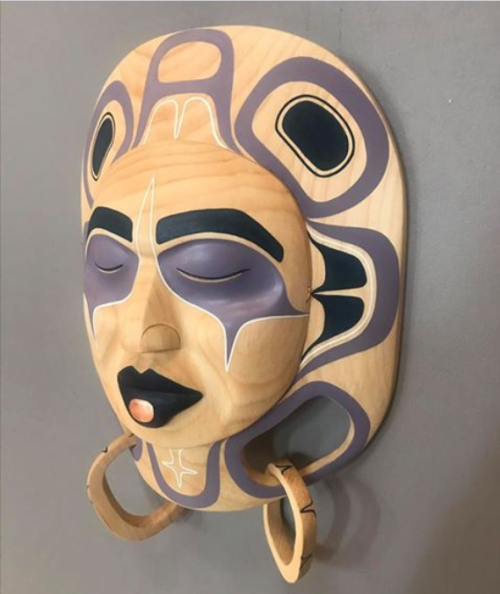Kelly Robinson is one of my favorite First Nations artists. I live with two of his paintings and three of his masks, all of which are strikingly different. Partly, his versatility is explained by the fact he works in both the Nuxalk and Nuu-chah-nulth traditions, but, whatever the reason, he is always trying something new. “Shamed Spirit” is no exception, although I have put off writing about it for several months, waiting for him to tell me more.
Until the other week, the mask didn’t even have a name. Robinson himself seems reluctant to talk about it, suggesting it is highly personal.
I recognized, of course, that it is a ridicule mask. Ridicule masks are a tradition on the Northwest Coast, a public display reproof of someone’s behavior through the destruction of artwork. This gesture is, perhaps, comparable to the breaking of a copper, as Beau Dick did a few years ago on the grounds of the British Columbia legislature and later at the Canadian Parliament Buildings – a gesture of contempt emphasized by the destruction of something personal and beautiful.
Modern ridicule masks generally feature the marring of half a mask. Often, they make a similar statement to Dick’s breaking of a copper; I remember Mike Dangeli, for example, contributing a ridicule mask that was an overt comment about the treatment of the First Nations to the opening show at the Bill Reid Gallery.
However, I still don’t know whether Robinson intends a similar comment. From a couple of hints, it might be a comment about sexual abuse, although how personal or how political it might be, I am no means sure.
Still, no matter what the target of the mask might be, it remains a powerful symbol. From the right side of the mask, you can see that the design is a mature display of skill, simple yet striking and well-finished. The left side, which Robinson tells me actually spent some time in a fire (and still smells like it did) is both a tragedy for lovers of art, and an expression of strong emotion. After all, who destroys such a piece of art without a strong motivation?
The whole idea of a ridicule mask seems the ultimate example of passive-aggressiveness, a gesture whose sincerity is undeniable, yet comes at a tremendous cost, both personally and aesthetically. I can only hope that one day I get to hear the story behind “Shamed Spirit,” because as a statement, it seems important – even to my limited understanding. But, then, who says that art is supposed to be easy?




























